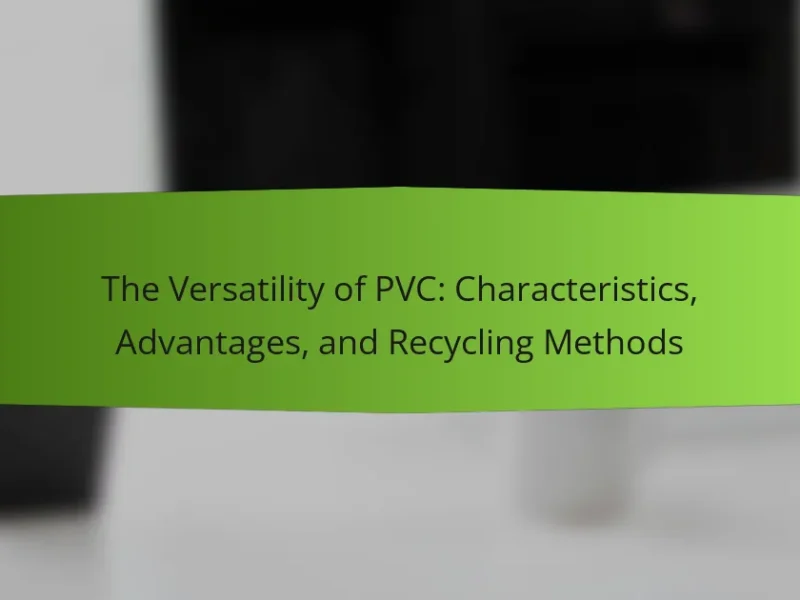Polypropylene is a versatile thermoplastic polymer produced through the polymerization of propylene monomers, known for its durability and high melting point. This material is widely used in various applications, including packaging, textiles, automotive parts, and consumer goods, due to its lightweight nature and resistance to chemicals and moisture. The article explores the manufacturing processes of polypropylene, such as bulk, solution, and gas-phase polymerization, which ensure consistent production of high-quality resin. Additionally, it highlights the benefits of polypropylene, including its recyclability and thermal resistance, emphasizing its significance across multiple industries.
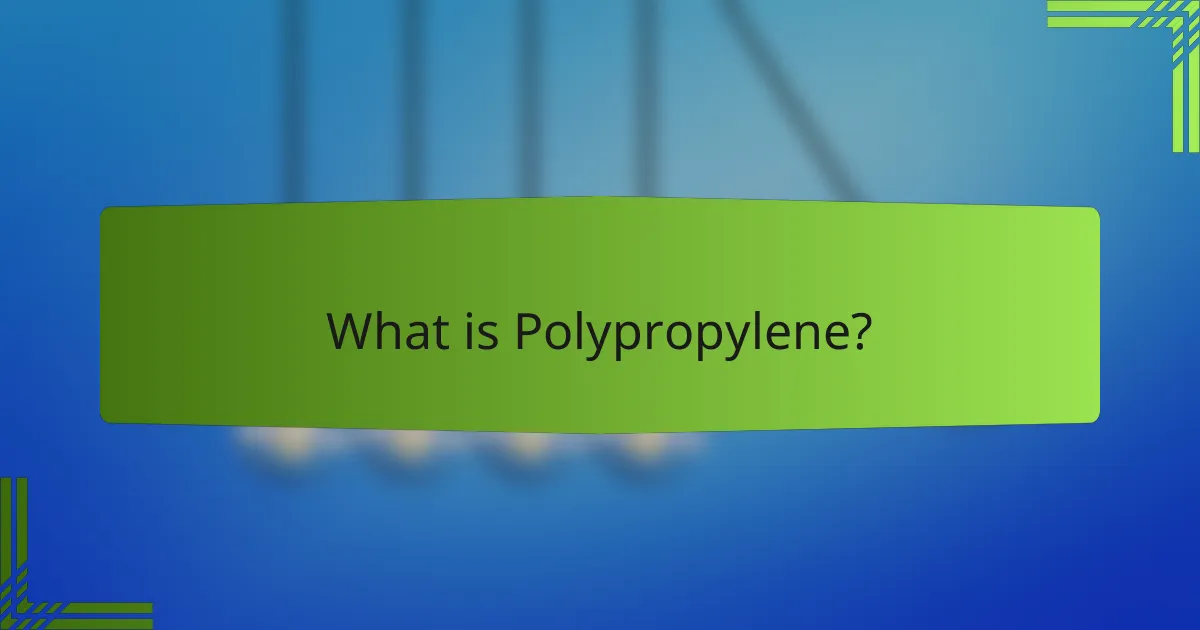
What is Polypropylene?
Polypropylene is a thermoplastic polymer used in a variety of applications. It is known for its versatility and durability. This polymer is produced through the polymerization of propylene monomers. Polypropylene has a high melting point, making it suitable for heat-resistant applications. It is commonly used in packaging, textiles, automotive parts, and consumer goods. The material is lightweight and resistant to chemicals and moisture. Its properties make it an ideal choice for both industrial and household products. Polypropylene is recyclable, contributing to its sustainability profile.
How is Polypropylene classified?
Polypropylene is classified as a thermoplastic polymer. This classification indicates that it can be melted and reshaped multiple times without significant degradation. Polypropylene is further categorized into various types based on its molecular structure. These include isotactic, syndiotactic, and atactic polypropylene. Isotactic polypropylene has a high degree of crystallinity and exhibits superior strength and stiffness. Syndiotactic polypropylene has a regular alternating arrangement of methyl groups, leading to unique properties. Atactic polypropylene is amorphous and rubber-like, making it less rigid. This classification is supported by its chemical structure and physical properties, which dictate its applications in various industries.
What are the different types of Polypropylene?
The different types of Polypropylene include Homopolymer, Copolymer, and Random Copolymer. Homopolymer polypropylene consists of a single type of monomer. It is known for its high strength and rigidity. Copolymer polypropylene is made from two different monomers. This type offers improved impact resistance and flexibility. Random copolymer polypropylene has a more random arrangement of monomers. It provides better clarity and is often used in packaging applications. Each type has unique properties suited for various applications in industries.
What are the key characteristics of Polypropylene?
Polypropylene is a thermoplastic polymer known for its versatility and durability. It exhibits excellent chemical resistance, making it suitable for various applications. Polypropylene has a low density, which contributes to its lightweight nature. It also possesses a high melting point, typically around 160°C, allowing it to withstand heat. The material is resistant to moisture and can be used in wet environments without degrading. Polypropylene is also recyclable, which enhances its sustainability profile. Its good impact resistance makes it ideal for packaging and automotive components. Additionally, it can be easily molded and shaped during manufacturing processes.
Why is Polypropylene important in various industries?
Polypropylene is important in various industries due to its versatility and cost-effectiveness. It is widely used in packaging, automotive, textiles, and consumer goods. Polypropylene’s lightweight nature makes it ideal for packaging applications. It offers excellent chemical resistance, enhancing its utility in automotive components. The material can be molded into various shapes, facilitating diverse product designs. Polypropylene is also recyclable, contributing to sustainable practices in manufacturing. In 2020, the global polypropylene market was valued at approximately $82 billion, reflecting its significant industrial demand. Its properties, such as durability and resistance to moisture, further solidify its importance across sectors.
What roles does Polypropylene play in manufacturing?
Polypropylene plays multiple roles in manufacturing, primarily as a versatile thermoplastic. It is used in producing various items, including packaging materials, automotive components, and textiles. Its lightweight nature contributes to fuel efficiency in vehicles. Polypropylene’s chemical resistance makes it ideal for containers and industrial applications. Additionally, it is employed in the production of fibers for carpets and clothing. The material’s durability and flexibility enhance its usability across diverse sectors. According to the Plastics Industry Association, polypropylene accounts for about 20% of the total plastic consumption in North America. This statistic underscores its significance in manufacturing processes.
How does Polypropylene compare to other plastics?
Polypropylene is known for its durability and lightweight properties, making it advantageous compared to other plastics. It has a higher melting point than polyethylene, allowing it to withstand heat better. Polypropylene also exhibits excellent chemical resistance, outperforming polystyrene in many applications. Additionally, it is more flexible than PVC, which enhances its usability in various products. The recycling rate of polypropylene is higher than that of some other plastics, such as PET. This makes it a more environmentally friendly option. Furthermore, polypropylene is often less expensive to produce than many other plastics, contributing to its widespread use in packaging and automotive industries.
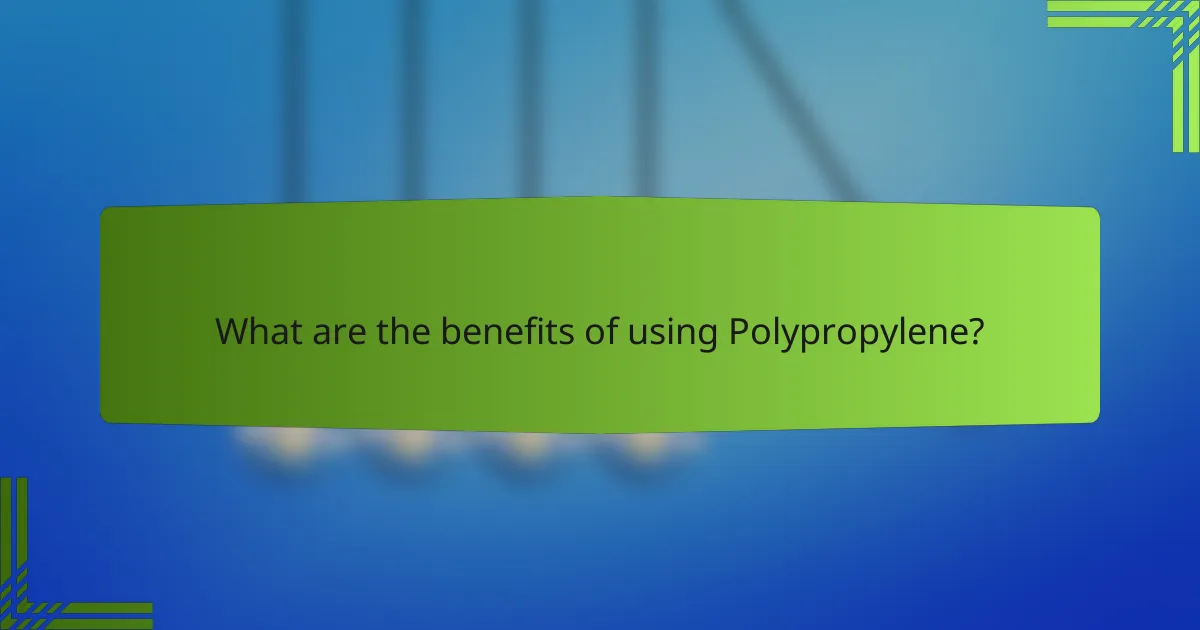
What are the benefits of using Polypropylene?
Polypropylene offers numerous benefits, making it a widely used material. It is lightweight yet strong, providing durability in various applications. Polypropylene is resistant to chemicals, moisture, and UV light, enhancing its longevity. Its low density contributes to energy efficiency in transportation and manufacturing. This material is also recyclable, promoting environmental sustainability. Additionally, polypropylene has excellent thermal resistance, making it suitable for high-temperature applications. Its versatility allows for diverse forms, including fibers, films, and molded products. These attributes collectively make polypropylene a preferred choice in industries such as packaging, automotive, and textiles.
How does Polypropylene contribute to sustainability?
Polypropylene contributes to sustainability through its recyclability and lower environmental impact. It can be recycled multiple times without significant loss of quality. This reduces waste and conserves resources. Additionally, polypropylene production has a lower carbon footprint compared to other plastics. Studies show it requires less energy to produce. Furthermore, polypropylene is lightweight, leading to reduced fuel consumption during transportation. Its durability extends product life, minimizing the need for replacements. These factors collectively support sustainable practices in manufacturing and consumption.
What are the environmental benefits of Polypropylene?
Polypropylene offers several environmental benefits. It is recyclable, which reduces waste in landfills. Approximately 30% of polypropylene is recycled in various applications. Its production process generates fewer greenhouse gases compared to other plastics. Polypropylene has a lower density, leading to reduced energy consumption during transportation. Additionally, it is resistant to moisture, which extends the lifespan of products made from it. This durability contributes to less frequent replacement, minimizing resource use. Overall, these attributes make polypropylene a more sustainable choice in the plastic industry.
How does Polypropylene’s recyclability impact its usage?
Polypropylene’s recyclability significantly enhances its usage in various applications. This material can be recycled multiple times without losing its properties. As a result, manufacturers are encouraged to use polypropylene in products designed for a circular economy. The recycling process reduces waste and conserves resources. According to the American Chemistry Council, polypropylene has a recycling rate of around 10%. This low rate indicates potential for improvement but also highlights the importance of recycling initiatives. Increased recycling can lead to cost savings and environmental benefits. Overall, recyclability influences product design, consumer choice, and sustainability efforts in industries using polypropylene.
What physical properties make Polypropylene advantageous?
Polypropylene is advantageous due to its excellent chemical resistance, high tensile strength, and low density. Its chemical resistance allows it to withstand various solvents and acids without degrading. The high tensile strength enables it to endure significant stress without breaking. Low density contributes to its lightweight nature, making it easy to handle and transport. Additionally, polypropylene exhibits good thermal stability, maintaining its properties at elevated temperatures. Its resistance to moisture further enhances its durability in various environments. These physical properties make polypropylene a preferred choice for many applications in packaging, automotive, and consumer goods.
How does the flexibility of Polypropylene affect its applications?
The flexibility of polypropylene significantly enhances its applications. This property allows it to be molded into various shapes and forms. Flexible polypropylene can withstand bending and stretching without breaking. This makes it suitable for products like containers, packaging, and automotive parts. Its flexibility also contributes to its lightweight nature. Lightweight materials reduce transportation costs and improve fuel efficiency in vehicles. Furthermore, flexible polypropylene can be easily processed using techniques like injection molding and blow molding. These processing methods enable mass production of diverse products. Overall, the flexibility of polypropylene broadens its usability across multiple industries.
What is the thermal resistance of Polypropylene?
The thermal resistance of Polypropylene is approximately 0.20 to 0.25 m²·K/W. This value indicates its effectiveness as an insulator. Polypropylene is known for its low thermal conductivity, typically around 0.1 W/m·K. This property makes it suitable for applications requiring thermal insulation. The material’s resistance to heat is beneficial in various industries, including packaging and automotive. Studies have shown that Polypropylene maintains its structural integrity under moderate heat exposure.
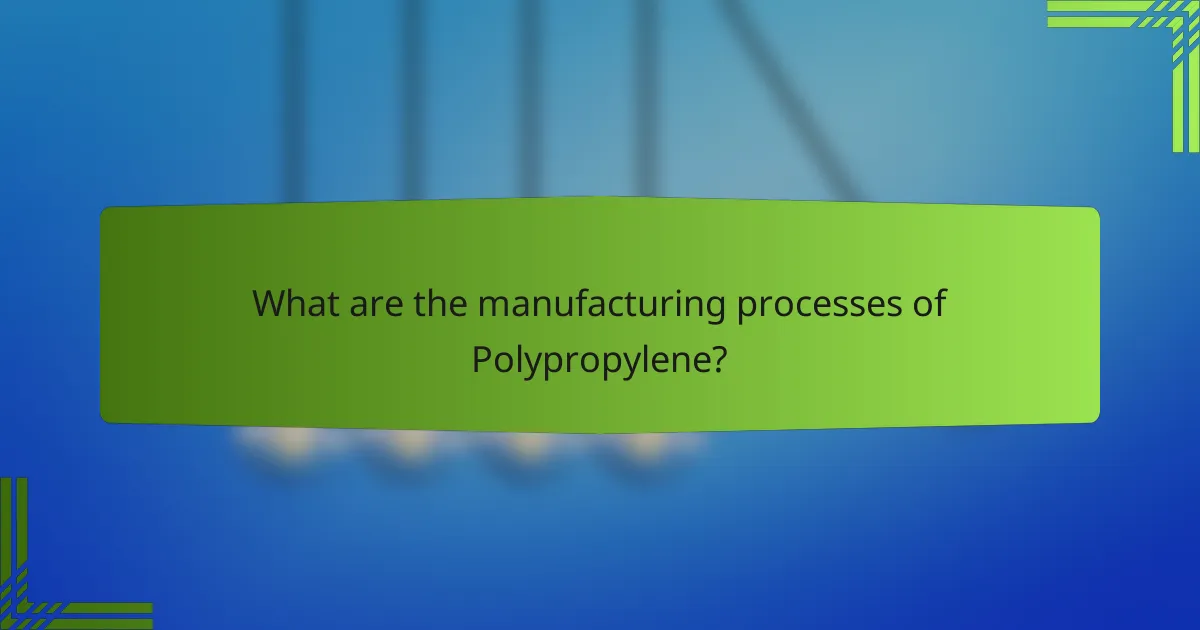
What are the manufacturing processes of Polypropylene?
The manufacturing processes of polypropylene include polymerization methods such as bulk, solution, and gas-phase polymerization. These processes convert propylene monomers into polypropylene resin.
Bulk polymerization involves using a small amount of solvent. This method allows for high purity and high molecular weight polypropylene.
Solution polymerization utilizes a solvent to dissolve the propylene. It offers better control over molecular weight and polymer properties.
Gas-phase polymerization operates in a fluidized bed reactor. This method is efficient and produces high-quality polypropylene with specific properties.
These processes are widely adopted in the industry, ensuring consistent production of polypropylene for various applications.
How is Polypropylene produced?
Polypropylene is produced through a process called polymerization. This involves the chemical reaction of propylene monomers. The polymerization can occur via two main methods: bulk (or mass) polymerization and gas-phase polymerization. In bulk polymerization, propylene is heated under pressure in the presence of a catalyst. This generates a high molecular weight polymer. In gas-phase polymerization, propylene gas is reacted in a reactor with a catalyst at specific temperatures and pressures. This method allows for better control over the polymer’s properties. The resulting polypropylene can then be processed into various forms for commercial use.
What are the steps involved in the polymerization of Propylene?
The steps involved in the polymerization of propylene include initiation, propagation, and termination. In the initiation step, a catalyst activates the propylene monomers. This catalyst can be a Ziegler-Natta or metallocene type. During propagation, the activated monomers link together to form long polymer chains. The reaction continues until the desired molecular weight is achieved. In the termination step, the polymerization process is stopped. This can be done by adding a terminating agent or by deactivating the catalyst. These steps are essential for producing polypropylene, a widely used thermoplastic polymer.
What technologies are used in Polypropylene manufacturing?
Polypropylene manufacturing utilizes various technologies, primarily including polymerization processes. These processes can be categorized into gas-phase, bulk, and solution polymerization. Gas-phase polymerization involves the use of a fluidized bed reactor, which allows for efficient heat transfer and catalyst activity. Bulk polymerization, on the other hand, occurs in a single phase, typically using a continuous stirred-tank reactor. Solution polymerization operates in a solvent, which helps control the molecular weight of the polymer. Each method has its specific advantages regarding efficiency, control, and product quality. These technologies are essential for producing polypropylene with desired properties for various applications.
What quality control measures are necessary in Polypropylene production?
Quality control measures in polypropylene production include monitoring raw material quality, process control, and final product testing. Raw materials must meet specific standards for purity and consistency. Process control involves maintaining optimal temperature and pressure during polymerization. Regular sampling and testing of the polypropylene are essential to ensure it meets specifications. Common tests include melt flow index, tensile strength, and impact resistance. These measures help prevent defects and ensure product reliability. Implementing these quality control measures is crucial for maintaining industry standards and customer satisfaction.
How do testing methods ensure Polypropylene quality?
Testing methods ensure Polypropylene quality by evaluating its physical and chemical properties. These methods include mechanical testing, thermal analysis, and chemical composition analysis. Mechanical testing assesses tensile strength, elasticity, and impact resistance. Thermal analysis measures melting temperature and thermal stability. Chemical composition analysis ensures the absence of contaminants and verifies polymer structure. Industry standards, such as ASTM and ISO, guide these testing methods. Compliance with these standards confirms that Polypropylene meets required specifications for durability and performance. Regular testing during production helps maintain consistent quality and reliability in end products.
What standards govern the production of Polypropylene?
Standards governing the production of Polypropylene include ASTM D4101 and ISO 1873. ASTM D4101 specifies the requirements for Polypropylene materials used in various applications. ISO 1873 outlines the classification and specifications for Polypropylene resins. These standards ensure consistency in quality, performance, and safety. Compliance with these standards is crucial for manufacturers. It helps in meeting industry regulations and customer expectations. Adhering to these standards also facilitates international trade.
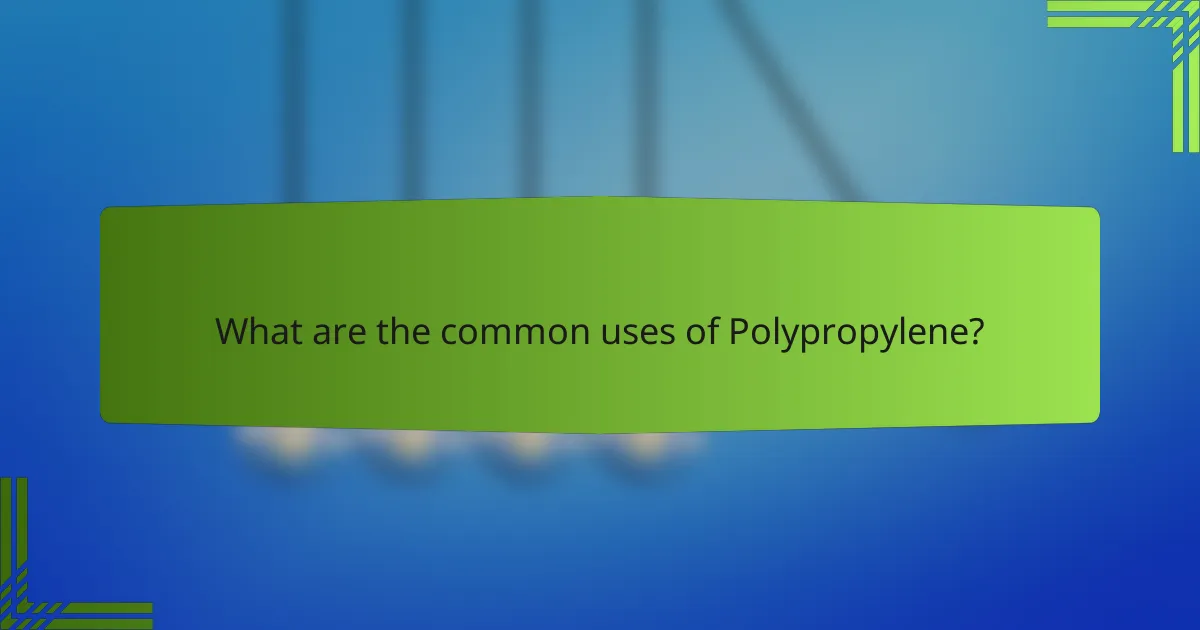
What are the common uses of Polypropylene?
Polypropylene is commonly used in packaging, textiles, automotive parts, and consumer goods. In packaging, it is utilized for containers, films, and labels due to its lightweight and moisture-resistant properties. Textiles made from polypropylene include carpets, upholstery, and non-woven fabrics, valued for their durability and stain resistance. In the automotive industry, polypropylene is used for interior components, bumpers, and battery cases. Consumer goods such as toys, household items, and medical supplies are often made from polypropylene, benefiting from its versatility and chemical resistance. These applications highlight polypropylene’s significance across various industries, underscoring its practicality and effectiveness.
In which industries is Polypropylene widely used?
Polypropylene is widely used in various industries. It is prevalent in packaging, automotive, textiles, and consumer goods sectors. In packaging, polypropylene is valued for its durability and moisture resistance. The automotive industry utilizes polypropylene for interior parts and bumpers due to its lightweight nature. Textiles incorporate polypropylene in non-woven fabrics and carpets. Consumer goods often feature polypropylene in containers and household items. These applications demonstrate polypropylene’s versatility and significance across multiple industries.
What are the applications of Polypropylene in packaging?
Polypropylene is widely used in packaging due to its versatility and durability. Common applications include food packaging, where it provides excellent moisture barrier properties. It is also used for creating containers, such as bottles and jars, which are lightweight and resistant to impact. Additionally, polypropylene films are utilized for wrapping and sealing products, ensuring freshness and protection. The material is suitable for both flexible and rigid packaging formats. Its chemical resistance makes it ideal for packaging chemicals and pharmaceuticals. According to the Plastics Industry Association, polypropylene accounts for a significant portion of the packaging market due to these attributes.
How is Polypropylene utilized in automotive parts?
Polypropylene is utilized in automotive parts primarily for its lightweight and durable properties. It is commonly used in interior components such as dashboards, door panels, and seat covers. Polypropylene’s resistance to chemicals makes it suitable for various under-the-hood applications. It also serves in manufacturing bumpers and other exterior parts due to its impact resistance. The material can be easily molded into complex shapes, enhancing design flexibility. Additionally, polypropylene is recyclable, aligning with industry sustainability goals. Its versatility and cost-effectiveness contribute to its widespread adoption in the automotive sector.
What innovative uses of Polypropylene are emerging?
Innovative uses of polypropylene are emerging in various sectors. In the automotive industry, polypropylene is being used for lightweight components to enhance fuel efficiency. In healthcare, it is utilized for manufacturing medical devices and packaging due to its sterilization properties. The construction sector is adopting polypropylene-based materials for insulation and piping systems. Additionally, it is being employed in the production of sustainable packaging solutions, reducing environmental impact. Recent research highlights the use of polypropylene in 3D printing applications, expanding its versatility. These advancements demonstrate polypropylene’s adaptability across different industries.
How is Polypropylene being used in medical applications?
Polypropylene is used in medical applications primarily for its biocompatibility and durability. It is commonly utilized in the production of medical devices such as syringes, containers, and surgical instruments. Its resistance to chemicals and moisture makes it suitable for sterilization processes. Polypropylene is also employed in the manufacturing of non-woven fabrics for surgical masks and gowns. The material’s lightweight nature enhances patient comfort in various medical settings. Studies indicate that polypropylene can be safely used in long-term implants due to its inert properties. Additionally, its recyclability contributes to sustainable practices in the medical field.
What are the trends in Polypropylene product development?
Trends in polypropylene product development include increased sustainability, enhanced recyclability, and improved performance characteristics. Manufacturers focus on bio-based polypropylene to reduce environmental impact. Innovations in polymer blends enhance strength and flexibility. There is a growing demand for lightweight materials in automotive and packaging industries. Advanced processing techniques are being adopted to create more complex shapes and designs. The market is also seeing a rise in the use of polypropylene in medical applications due to its biocompatibility. Additionally, smart polypropylene materials with integrated sensors are emerging for various applications. These trends reflect the industry’s commitment to innovation and sustainability.
What are some best practices for working with Polypropylene?
Best practices for working with polypropylene include maintaining proper temperature control during processing. Polypropylene has a melting point of approximately 160°C. This temperature must not be exceeded to avoid degradation.
Use appropriate molds to ensure even cooling and minimize warping. Mold temperatures should be maintained between 20°C to 60°C for optimal results.
When machining polypropylene, use sharp tools to achieve clean cuts. This reduces the risk of melting the material during the process.
In addition, ensure proper ventilation when welding or bonding polypropylene. Fumes can be released during these processes, which may pose health risks.
Finally, store polypropylene in a cool, dry place away from direct sunlight. This prevents degradation and maintains the material’s properties over time.
Polypropylene is a versatile thermoplastic polymer known for its durability, lightweight nature, and chemical resistance, making it suitable for a wide range of applications across various industries, including packaging, automotive, textiles, and consumer goods. The article covers the classification of polypropylene, its key characteristics, and the different types, such as homopolymer and copolymer. It also discusses the manufacturing processes, quality control measures, and the environmental benefits of polypropylene, including its recyclability and sustainability profile. Additionally, the article highlights innovative uses and trends in polypropylene product development, emphasizing its significance in modern manufacturing and design.


